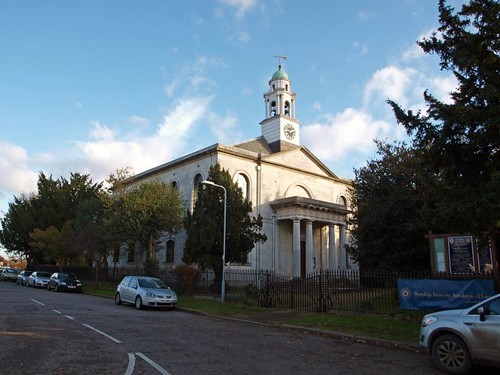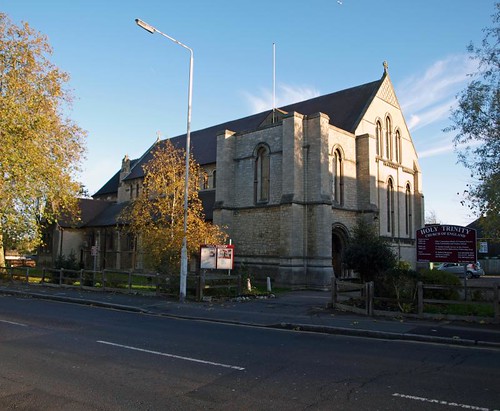ST MARY. A church worthy in its appearance of the noble aspiration of the mansion. Built in 1790 by Thomas Hardwick, in a classical style, clearly of Gibbs derivation. Ashlar-faced throughout. Tall porch of two pairs of Tuscan columns. Pediment and fine circular bell turret with pairs of columns in the diagonals. Windows in two storeys corresponding to the wooden galleries inside. Interior of five bays of tall Corinthian columns on high pedestals. The columns carry arches, the ceiling is coved. Narrower chancel. - PULPIT. Lovely, with sounding board carried on two palmtree columns. - High BOX PEWS. - COMMUNION RAILS and COMMUNION RAILS of wrought iron. - PLATE. Set of Queen Anne date converted to its present appearance in 1790. - MONUMENTS. The monument to Sir Josiah Child d. 1699 is one of the show pieces of the period. Attributed by Mrs Esdaile to John van Ost or Nost. Large reredos back. On the pedestal the reclining figure of a son of Sir Josiah and two allegories. Higher up stands Sir Josiah in Roman vestments and wig. Corinthian columns l. and r. and open, broken segmental pediment with Fames reclining on it. All the ornamental carving very fine. - George Bowles d. 1817, by Chantrey (on the gallery). Large seated female and next to her on a high pedestal bust in profile.
CHRIST CHURCH, High Street. 1861 by Sir George Gilbert Scott. Spire, S aisle etc. a little later. The church stands in the Recreation Ground, unconcerned with any houses around, like a model in an exhibition. The Victorians liked that. Ragstone with N tower with spire. The windows have plate tracery. Low quatrefoil piers. Three separate roofs for nave and aisles.
ST GABRIEL, Aldersbrook Road. 1914 by Charles Spooner. Red brick. Good Neo-Perp with pretty fléche.
HOLY TRINITY. Hermon Hill. 1887-9 by J‘. Fowler. Neo-Norman, an unusual thing at that time, with NW tower standing outside the aisle.
WANSTEAD. London has flowed into it, but has not been able to engulf this ancient place, for it is protected on all sides by forest land and open spaces, Wanstead Park and Wanstead Flats, and a lake-filled corner of Epping Forest.
A colony of over a hundred herons has settled in the park, of which 200 acres belong to the City of London; we could scarcely have believed in these cockney herons had we not seen their nests, 60 of them. The park was beautifully laid out by Richard Child, first Earl Tylney, whose father and brother we find in the church, but the gorgeous house he built has gone these hundred years. Louis the Eighteenth and his queen lived in it, refugees during the Napoleon wars, when they lived chiefly at Hartwell in Bucks. In an earlier house standing on this site took place the marriage of the Earl of Leicester and the Countess of Essex, of which no one dared tell Queen Elizabeth for a year, so much had she wished to marry the man herself.
Among the new shops in the High Street are some 18th century homes, one the manor house with a beautiful hooded doorway; and for contrast there is a tiny timbered cottage of the 17th century 14 feet by 7. The Spanish chestnuts on the green are much older than the church they lead us to, a classical building of 1790 with a pillared porch and a cupola. Under a richly carved canopy is a rare three-
decker pulpit. There are some Chippendale chairs, a beautiful lectern, and a modern candelabra presided over by a two-headed eagle. A portrait in relief shows George Bowles, a lover of art who died in 1817.
Almost filling a wall of the chancel is the monument of Josiah Child and his son Bernard, who both appear in Roman costume, one lying on a shelf, the other standing on a pedestal with angels blowing trumpets above his head. Sir Josiah, a City merchant and economist (but not the banker) died in 1699. He was for a time Governor of the East India Company, one of whose chaplains lies in the churchyard. The chaplain is James Pound, whose account of the mutiny of Indian troops on the Pulo Condore Islands is treasured in the Bodleian. He lost all in the insurrection, returned to England, became rector of Wanstead, and soon made a name as an astronomer. The Royal Society lent him a telescope, and Sir Isaac Newton procured the maypole from the Strand for him to mount it on. He fired his curate, James Bradley, with the same enthusiasm, and had he lived he would have had the joy of seeing this much-loved nephew succeed Edmund Halley as Astronomer-Royal.
Flickr.
A colony of over a hundred herons has settled in the park, of which 200 acres belong to the City of London; we could scarcely have believed in these cockney herons had we not seen their nests, 60 of them. The park was beautifully laid out by Richard Child, first Earl Tylney, whose father and brother we find in the church, but the gorgeous house he built has gone these hundred years. Louis the Eighteenth and his queen lived in it, refugees during the Napoleon wars, when they lived chiefly at Hartwell in Bucks. In an earlier house standing on this site took place the marriage of the Earl of Leicester and the Countess of Essex, of which no one dared tell Queen Elizabeth for a year, so much had she wished to marry the man herself.
Among the new shops in the High Street are some 18th century homes, one the manor house with a beautiful hooded doorway; and for contrast there is a tiny timbered cottage of the 17th century 14 feet by 7. The Spanish chestnuts on the green are much older than the church they lead us to, a classical building of 1790 with a pillared porch and a cupola. Under a richly carved canopy is a rare three-
decker pulpit. There are some Chippendale chairs, a beautiful lectern, and a modern candelabra presided over by a two-headed eagle. A portrait in relief shows George Bowles, a lover of art who died in 1817.
Almost filling a wall of the chancel is the monument of Josiah Child and his son Bernard, who both appear in Roman costume, one lying on a shelf, the other standing on a pedestal with angels blowing trumpets above his head. Sir Josiah, a City merchant and economist (but not the banker) died in 1699. He was for a time Governor of the East India Company, one of whose chaplains lies in the churchyard. The chaplain is James Pound, whose account of the mutiny of Indian troops on the Pulo Condore Islands is treasured in the Bodleian. He lost all in the insurrection, returned to England, became rector of Wanstead, and soon made a name as an astronomer. The Royal Society lent him a telescope, and Sir Isaac Newton procured the maypole from the Strand for him to mount it on. He fired his curate, James Bradley, with the same enthusiasm, and had he lived he would have had the joy of seeing this much-loved nephew succeed Edmund Halley as Astronomer-Royal.
Flickr.




No comments:
Post a Comment